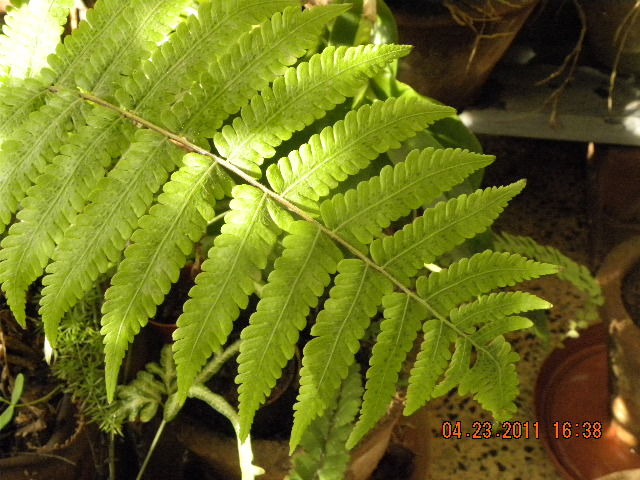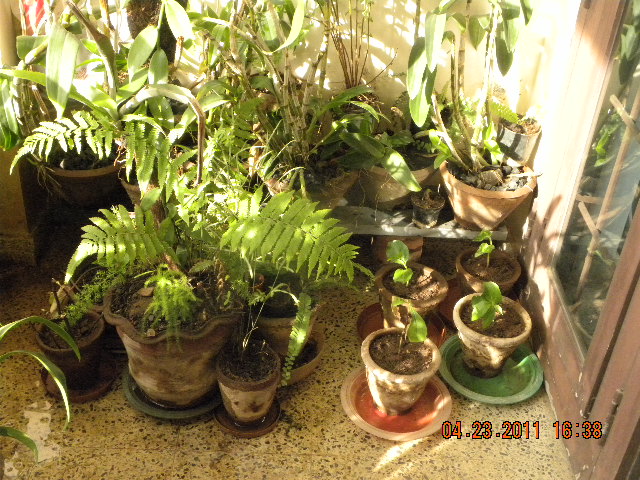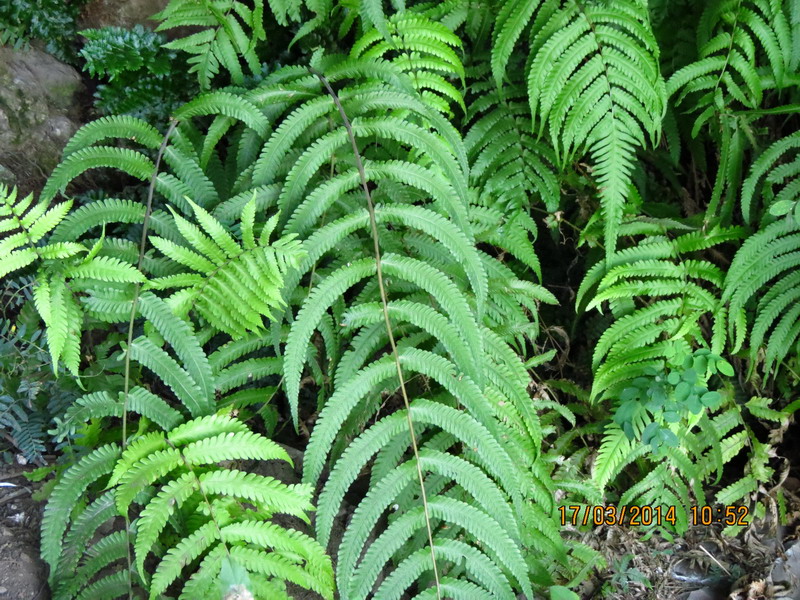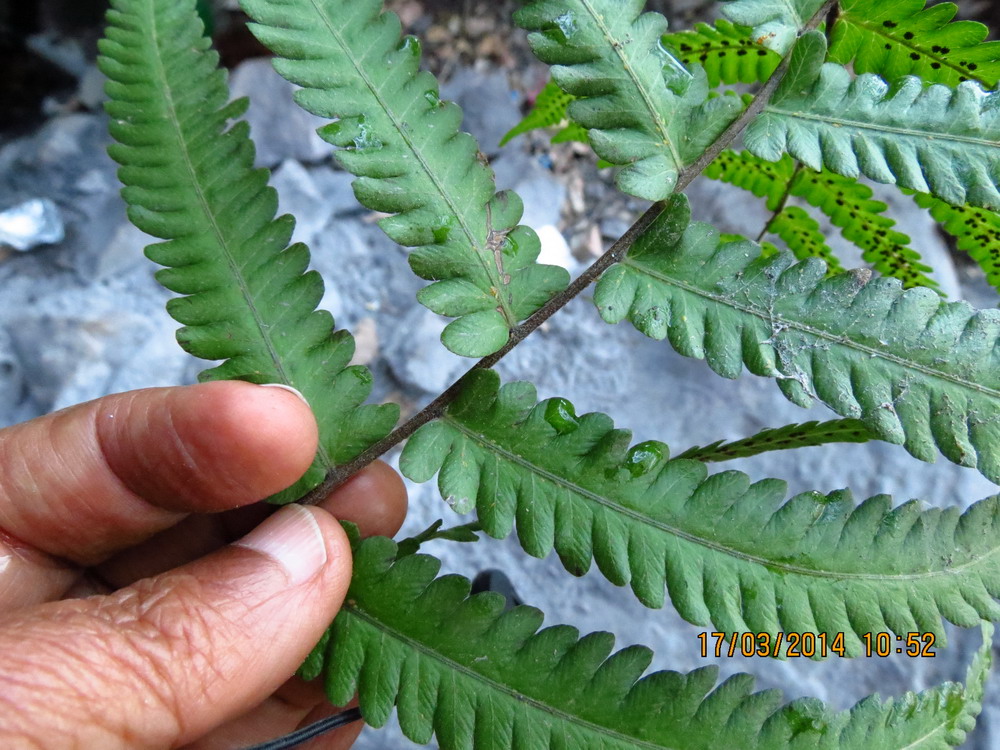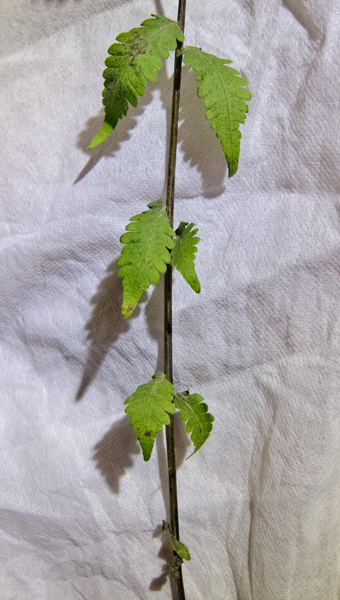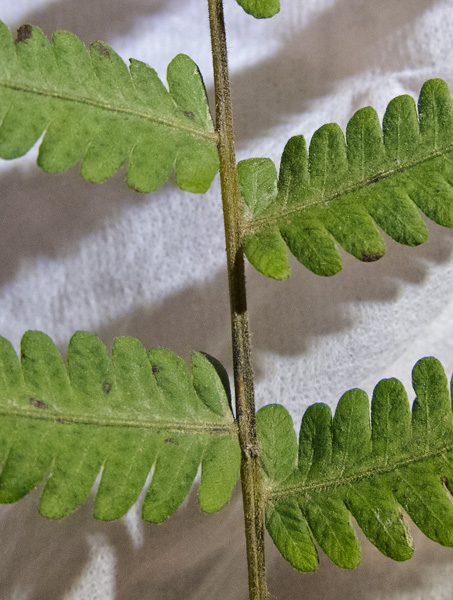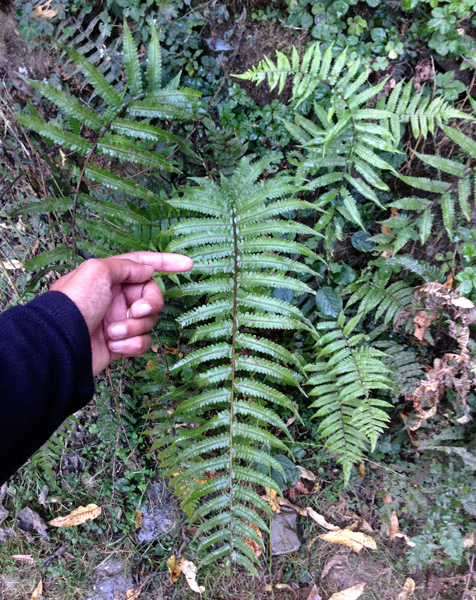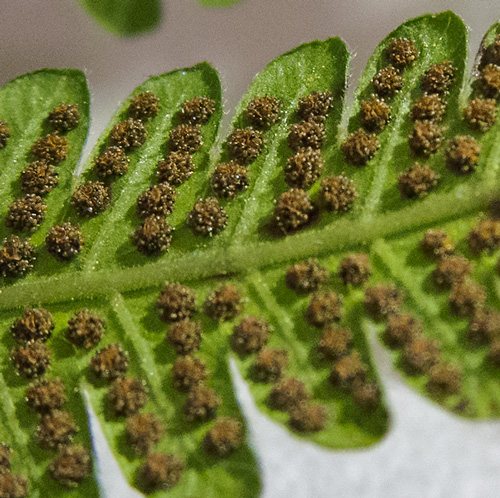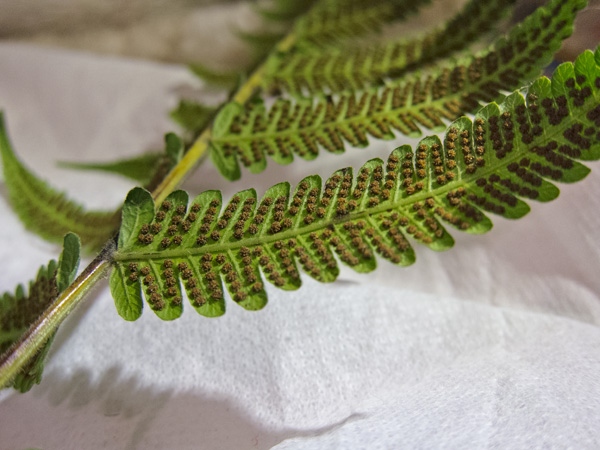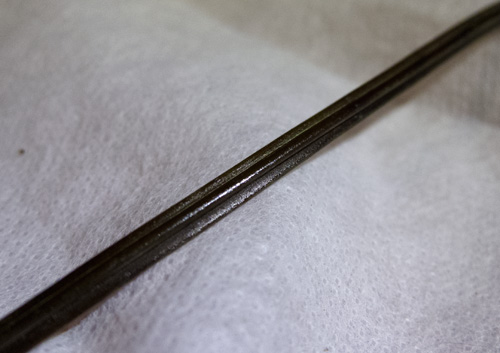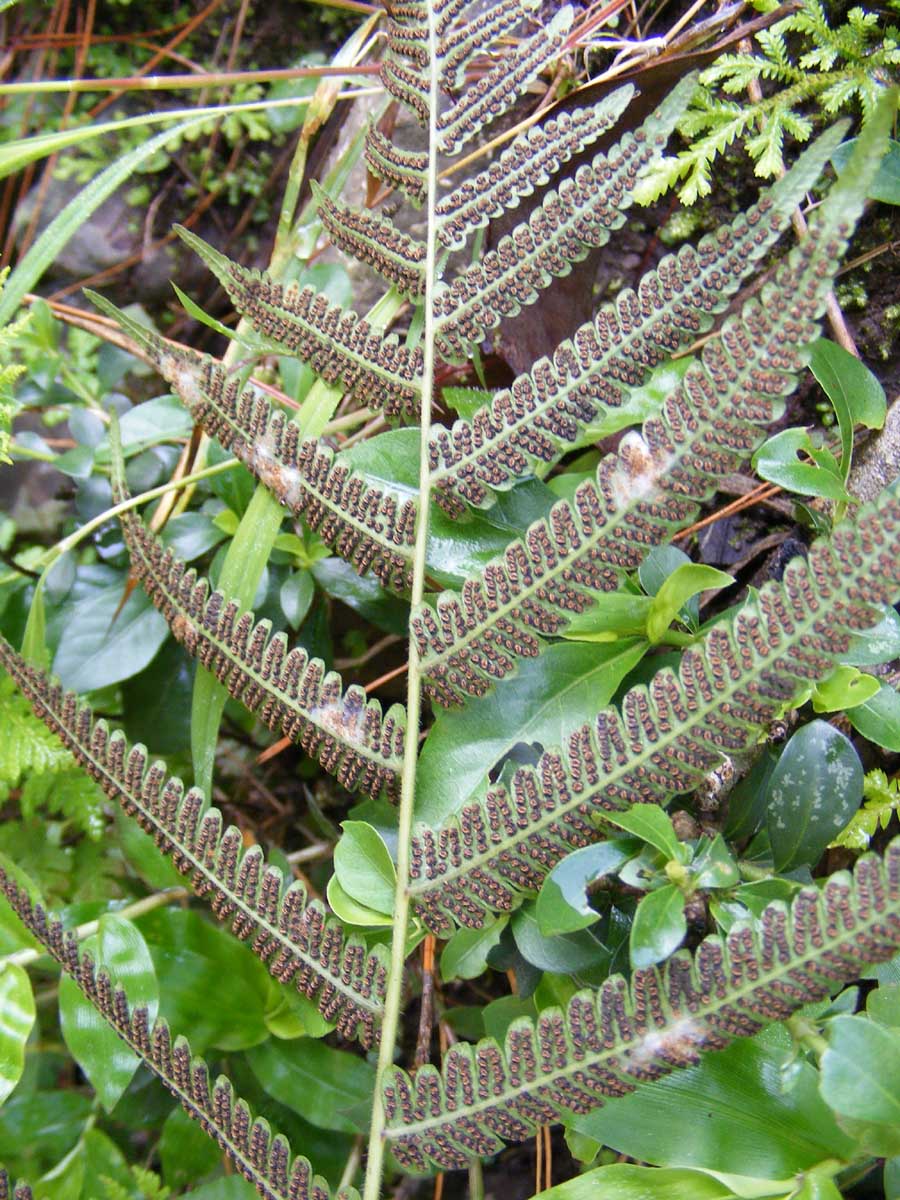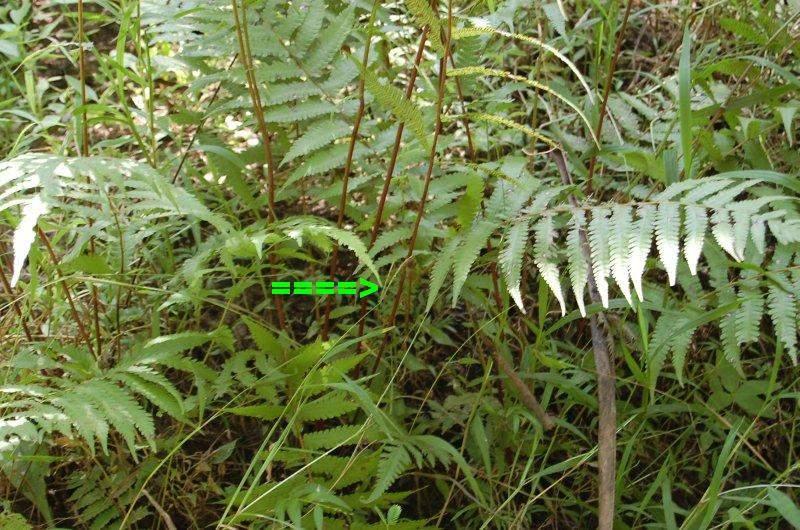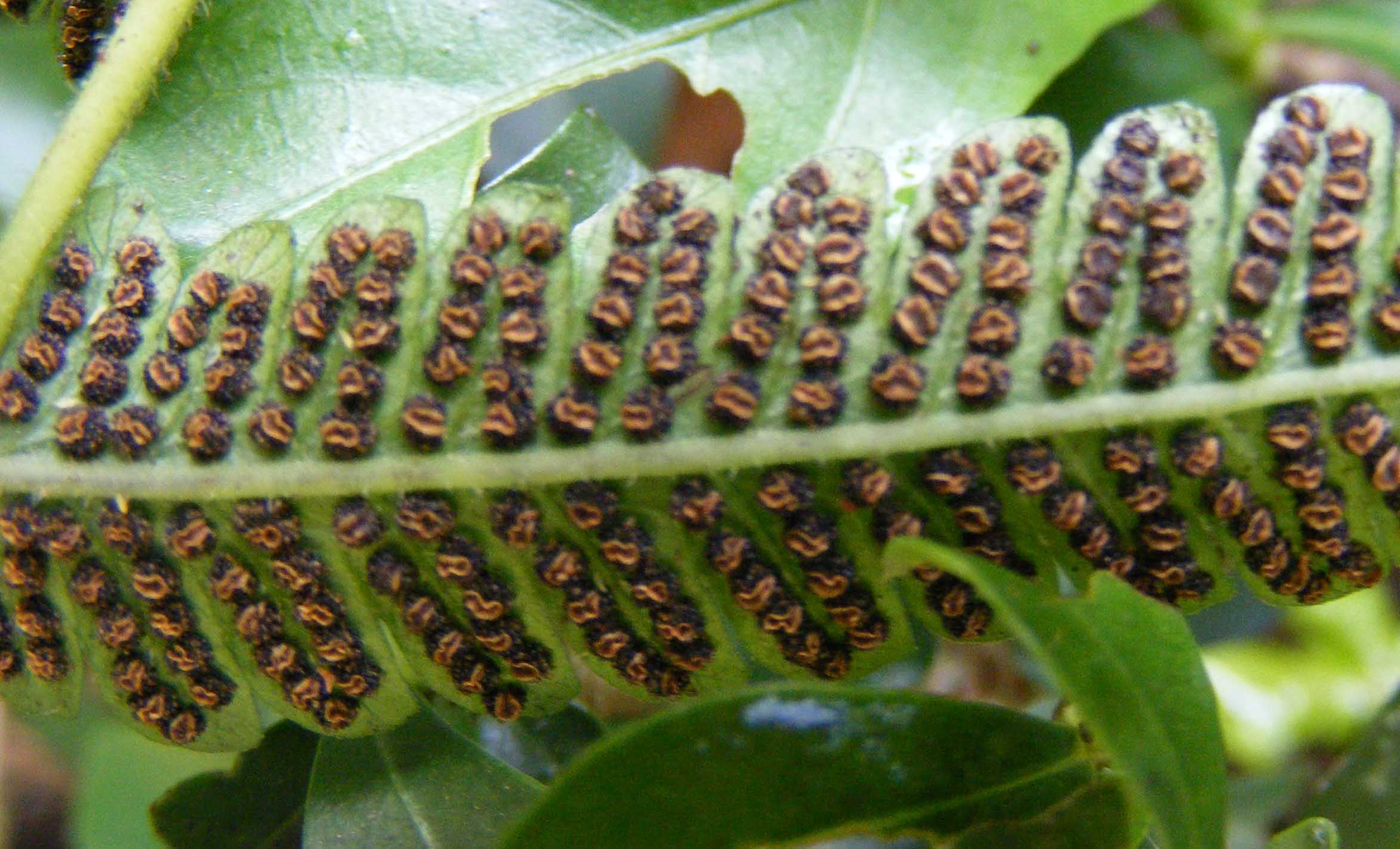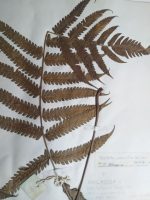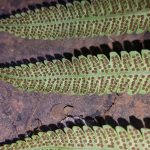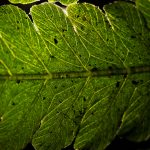|
Thelypteris dentata (Forssk.) E.P.St.John, Amer. Fern J. 26: 44 (1936) as per POWO;
.
Christella dentata (Forsk.) Brownsey & Jermy, Brit. Fern Gaz. 10(6): 338 1973. (syn: Aspidium aquapimense Schumach.; Aspidium hilsenbergii Sieb.; Aspidium molle Sw.; Aspidium natalense Fée; Aspidium nymphale (G. Forst.) Schkuhr; Aspidium violascens Link; Christella dentata var. caespitosa Holtt.; Christella dentata var. himalayensis Punetha & Kholia; Christella hilsenbergii (C. Presl) Holtt.; Christella malabariensis (Fée) Holtt.; Christella multiauriculata Punetha; Christella nymphalis (G. Forst.) Pichi-Serm.; Christella taprobanica (Panigrahi) Holtt.; Cyclosorus caespitosus (Holttum) Mazumdar & Mukhop.; Cyclosorus dentatus (Forsk.) R. C. Ching; Cyclosorus dentatus f. bipinnata Ching; Cyclosorus dentatus var. violascens (Link) Abbiatti; Cyclosorus dicarpus (Fée) Ching; Cyclosorus fengii Ching ex Shing; Cyclosorus hispidulus A. Peter; Cyclosorus jiulungshanensis P. S. Chiu & Yao ex Ching; Cyclosorus lanpingensis Ching; Cyclosorus lungmenensis Ching; Cyclosorus lushiensis Ching; Cyclosorus mekongensis Ching (ambiguous synonym); Cyclosorus mekongensis Ching ex Shing (ambiguous synonym); ………………………..; Thelypteris dentata (Forsk.) E.St. John ; ………………………); . Tropical & Subtropical Old World to Pacific: Afghanistan, Andaman Is., Angola, Ascension, Assam, Azores, Bangladesh, Benin, Bismarck Archipelago, Burkina, Burundi, Cameroon, Canary Is., Cape Provinces, Cape Verde, Caroline Is., Central African Repu, China South-Central, China Southeast, Comoros, Cook Is., East Himalaya, Equatorial Guinea, Ethiopia, Fiji, Gabon, Ghana, Guinea, Gulf of Guinea Is., Hainan, India, Iran, Iraq, Ivory Coast, Japan, Kenya, Kermadec Is., Korea, Kriti, KwaZulu-Natal, Laccadive Is., Lesser Sunda Is., Liberia, Madagascar, Madeira, Malawi, Malaya, Mali, Maluku, Marianas, Marquesas, Mauritius, Mozambique, Myanmar, Namibia, Nansei-shoto, Nepal, New Guinea, New South Wales, New Zealand North, Niger, Nigeria, Norfolk Is., Northern Provinces, Northern Territory, Pakistan, Philippines, Queensland, Rodrigues, Rwanda, Réunion, Santa Cruz Is., Saudi Arabia, Senegal, Seychelles, Sicilia, Sierra Leone, Society Is., Socotra, Solomon Is., South Australia, Spain, Sri Lanka, Sudan, Sulawesi, Swaziland, Taiwan, Tanzania, Thailand, Tibet, Tokelau-Manihiki, Tonga, Tuamotu, Tubuai Is., Uganda, Vanuatu, Victoria, Vietnam, West Himalaya, Western Australia, Yemen, Zambia, Zaïre, Zimbabwe; Introduced into: Alabama, Algeria, Argentina Northeast, Bahamas, Bolivia, Brazil Northeast, Brazil South, Brazil Southeast, Brazil West-Central, Central American Pac, Colombia, Costa Rica, Cuba, Easter Is., Ecuador, El Salvador, Florida, Georgia, Guatemala, Hawaii, Honduras, Jamaica, Kentucky, Leeward Is., Louisiana, Mexico Central, Mexico Gulf, Mexico Northeast, Mexico Southeast, Mexico Southwest, Mississippi, Morocco, Nicaragua, Panamá, Paraguay, Peru, Puerto Rico, South Carolina, Texas, Uruguay, Venezuela, Venezuelan Antilles, Windward Is. as per POWO; ..
PR 23-04-11 For ID. A fern.Chennai.: – If I had to guess, I would have gone for Christella dentata, but please check if the sorus are covered with indusium (a white covering onver the black spots.) – I also think Cyclosorus dentatus (Forssk.) Ching, synonym Christella dentata. – Christella dentata , morphology may will differ considerably in relation with soil and light . Fwd: [efloraofindia:186086] identification of these ferns requested LA2 : 4 posts by 1 author.
please help me in the identification of ferns photographed at Eastren ghats. Thelypteris (Sect. Cyclosorus) probably meeboldii or otherwise dentata. Necessary diagnostic features not shown in these photos:
1. Rhizome thin and long-creeping – meeboldii; or thick, shorter creeping – dentata.
2. Lamina-base wide – T. parasitica, or tapering – dentata and meeboldii.
3. venation to be seen – how many pairs of opposite veinlets anastomose beneath the inter-segmental sinus? Two or more – meeboldii; 1 and a half – dentata; 1 – parasitica. Thank you very much …, OK, yes, sounds like it – then usually 1 and a half pairs of veins anastomose below the sinus, less than in meeboldii. And T. dentata is slightly more hairy beneath than the almost glabrous (to the naked eye) T. meeboldii. . Fern ID requested : 8 posts by 3 authors. Attachments (1).
I had noticed this fern emerging out of the wall of a large drain in NIT Durgapur. Is it Cyclosorus? Is it Dryopteris odontoloma?? Thelypteris (Sect. Cyclosorus) dentata, probably the commonest and most widespread fern in India. Thanks a lot. It is not an insect. It is the exuvia of the Green Marsh Hawk Dragonfly. .
What fern?/ABDEC12 : 5 posts by 3 authors. Attachments (6) Deparia boryana
Christella dentata
Cyclogramma auriculata
Dryopteris nigropaleacea
More online poking about made me doubt the last two possibilities. I do not know how I can go any further. Please advise.
I took the first picture today on my phone. All others were taken last night under artificial light. I adjust the colour temperature in post processing to represent the colours as faithfully as possible.
Mcleodganj, Dharamshala, HP
1750m
A few ID points;
1. The stalk which is claret (more brown than red) with coppery sheen has a channel running though it. It gets paler as we approach the tip of the frond. The second picture taken higher up on the same frond shows the stipe to be almost green with white hair (scales) but the channel is still visible.
2. The bottom four pairs of pinnae are small and curling, gradually increasing in size. The maximum pinna length (about 9cm in my sample) is reached somewhere in the middle of the frond.
3. Sori are round and brown running along the edges of the pinnules. I counted between 7 and 10 on per pinnule (except where there are none) of this sample.
I’m very pleased to see you got it right down to two choices. This is great news, and a fine achievement. It is Thlypteris (Sect. Cyclosorus = Christella) dentata. You will see one and a half pairs of veinlets anastomose between each lobe, and rhizome horizontal. Thank you … for your help and for your encouraging words. I will find another sample with the rhizome soon and observe the veinlets closely.  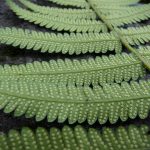 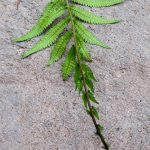  This was in winters and now these Thelypteris dentata ferns are maturing with white horse-shoe sori developing. Here are a few fresh images from today. 4 images. Absolutely fantastic photography Thank you … .
Pteridophyte – efloraofindia | Google Groups Thelypteris parasitica (L.) Tardieu (=Christella parasitica)
Wild fern from Western Ghats Tamilnadu.
I think it is much more likely to be T. (sect. Christella) denatata – but the photo is inadequate to show which, but it is not typical for T. parasitica at all.
1. I need to know if the rhizome was rather thinnish, long-creeping (parasitica), or thick and rather short-ish creeping (dentata). The rhizome condition is very important in Thelypteris.
2. The BOTTOM pinnae are always the most important – but are not pressed properly and are mostly out of the picture. In paratsitica they are longer and so is the lowests acroscopic pinna=lobe.
3. I need to see the venation against the light, close-up – 1 pair anastomosing = parasitica, one and a half anastomosing = dentata.
4. I need to see the hairs on the lower surface of a pinna. These look too sparse and short for parasitica. But it needs a close-up photo to show them. . Fern id please: 1 image. Taken in the month of Feb in Talakona forests, AP on the way to the waterfalls. Christella normalis? For nearly all ferns one must see the frond-base, not just upper halves as in so many field photos. It is one of the reasons why a herbarium-specimen photo is often better. For Thelypteris species, one also needs to know how the rhizome was, thick-erect with fronds together; thick horizontal, fronds together at apex; or thin long-creeping with fronds separate. This I can’t see in the photo.
However, I can just see the decreasing basal pinnae in one of the central fronds. Enough to confirm the general impression that it is Thelypteris (Christella) dentata.
If so, it should have a horizontal, thickish rhizome, with fronds together at one end; the basal pair or two pairs of veinlets between each pinna-lobe should anastomose beneath the sinus between lobes and the lower-surface of the costa should have rather obvious scattered stiff hairs, not very long.
But in south India T. dentata is obviously a complex and there seems to be another taxon, close to T. dentata, but with a thin, long-creeping rhizome with more separate fronds arising along it, and the costal hairs are shorter – and more usually two or two-and-a-half pairs of veinlets anastomosing. I think this is T. (Christella) meeboldii – and I collected it in the Shevaroys, Palnis and Kerala, and have seen it from Andhra. Dr. Sledge found that his Sri Lankan T. meeboldi had spinulose-ridged spores, unlike T. dentata, but if I understood the type correctly (no rhizome – of course!!) it seems to be the long, thin rhizome species. And some seem to have spinulose spores some not. See page 453 of my Annotated Checklist of Indian Pteridophytes vol. 1 (2016). That long-rhizomed thing is only in South India, not the north. But I just can’t be sure yet if it is meeboldii or not! My living plant from Kerala soon died unfortunately, so I only grew it for about a year. It is a different species from T. dentata anyway.
Perhaps you could tell me what the rhizome was like and we could make a more informed judgement? In general I think your plant looks to be normal T. dentata. Fern for id..? Alsophila (cyathea) gigantea: 5 images- 2 high res. On 2nd thoughts, it may be Thelypteris dentata.. the rhizome is creeping. Lamina base is tapering. I was misled by the pattern of sori.. Not this time! Way off, I’m sorry to say. Cyathea (Gymnosphaera) gigantea is glabrous beneath the pinnae and does not have small hairs like that anywhere. Also those sori are not in Vs – when you see real C. gigantea you will see V-lines of sori, quite different. Also the lowest pair of opposite veinlets anastomose beneath the space between the pinnules – they are free in C. gigantea.
This is Thelypteris (Christella) dentata agg. – I say agg., because in southern and W. peninsular India T. dentata includes two close species. True T. dentata has a rather short-creeping , thick rhizomes, closely surrounded by old stipe-bases, with fronds arising all together at its apex – and has a bit longer hairs beneath the pinna-costae. But the other taxaon, which is either T. malabarica or T. meeboldii (sorry I didn’t finally see which) has a much longer and thin, creeping rhizome with fronds rather well apart, and the hairs beneath the pinna-costae are smaller.
I vaguely guess your plant is the latter, but for Thelypteridaceae we need to know about the rhizome. I wonder if you photographed it? – Or included it in the herbarium-specimen?
Incidentally, both C. gigantea and T. dentata are terrestrial, not lithophytic. Lithophytic means growing on the side of the rock, not on the ground. Having stones in the ground between soil does not mean they are lithophytes. Yes, that’s right. How creeping was the creeping? Did you make a photo of the rhizome, as I mentioned in my identification.
The sori are not in Vs – but nearly parallel – you need to see a photo of C. gigantea sori, really in inverted Vs.
Yes, definitely dentata. The other one, which I think is T. meeboldii (see in my Indian Checklist vol. 2), has a thin, long rhizome not covered in close leaf-bases like this – and has fronds few and well apart, more like how they are in T. jaculosa.
The late Dr. Wolfgang Theuerkof at Gurukulla, Kerala, had lots of the meeboldii one growing wild in his natural park there and will still be there. . SK 3729 28 May 2023 – Fern: 7 very high images. Location: Gyaneswor, Kathmandu
Date: 29 May 2023
Elevation: 1400 m.
Habit : Wild Christella Christella dentata (Forssk.) Brownsey & Jermy ? Christella dentata
. References: |
Disclaimer
1. For any mistake in identification or for becoming efloraofindia e-group member (for contributing towards building of efloraofindia or otherwise), pl. mail to indiantreepix@googlegroups.com or itpmods@googlegroups.com
2. For better viewing of species’ pages, colour scheme & formatting is being followed as: Description of the species, Details of other flora species on the same page, Uses/ harms, Distribution, Abundance/ Location/ Flowering time & date, Habit & habitat, Etymology & pronunciation, Other interesting information, stories etc., Others, Botanical names, Common names, Main point of discussion below, Discussion about Botanical names.
Navigation
- Award for eFloraofIndia
- Colour scheme & formatting
- Copyrights, Permissions, Citations
- eFloraofIndia appreciated
- Names of Plants in India site
- Flowersofindia site
- Posting Guidelines
- For members’ information
- Logo, Tagline, Acronym
- Volunteers required
- ‘Pitamah’ of eFloraofIndia
- ‘अजेय’ ‘Ajey’ of eFloraofIndia
- ‘Saarthi’ ‘सारथि’ of eFloraofIndia
- ‘Jewel’ of eFloraofIndia
- ‘Grassman’ of eFloraofIndia

